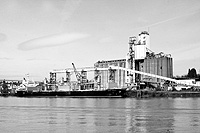forum
library
tutorial
contact

Big Ships No Threat to Ports
by Philip S. MooreCapital Press, November 23, 2007
|
the film forum library tutorial contact |

|
Big Ships No Threat to Portsby Philip S. MooreCapital Press, November 23, 2007 |
Columbia River dredging nears completion, but ship sizes keep growing
 It has taken a decade of planning and lobbying and eight years of construction, but the finish line for the Columbia River channel deepening is finally in sight.
It has taken a decade of planning and lobbying and eight years of construction, but the finish line for the Columbia River channel deepening is finally in sight.
Unfortunately, so is the finish line for another long-awaited project, expansion of the Panama Canal. And that may transform the Columbia River effort from a long-overdue necessity into something that's too little and too late to matter.
By 2010, possibly sooner, the Columbia River will finally have a 43-foot channel from Portland, Ore., to the Pacific Ocean. With it, Panamax vessels, with a draft of 40 feet, will be able to safely load to capacity at the grain terminals along the river.
"We should be 65-70 percent complete by the end of this fiscal year," said federal Columbia River system lobbyist Glenn Vanselow, executive director of the Pacific Northwest Waterways Association. "The president has endorsed the project, so the $29 million needed to finish the work will be coming soon.
"Then we'll have a channel that will meet our river system's needs well into the future," he said.
Despite his confidence that the 43-foot channel will be deep enough for all but the largest container ships and Capesize bulk carriers, the new and larger Panama Canal will open in 2014. That new canal will serve much larger vessels, with a draft of up to 58 feet. Panamax, as it now exists, will no longer be the largest ship that can transit the canal, and that could set off a race to build a new class of bulk carriers, almost twice the size of the ships now loading at Columbia River grain and bulk terminals.
Those ships, even with the deeper Columbia River channel, would again put the river system at a disadvantage, and this time the channel's depth may be an obstacle that can't ever be overcome.
It's hard to predict, said Dave Hunt, executive director of the Columbia River Channel Commission.
"Nobody does economic projects 50 years out," he said.
For the next 20 years, Hunt said the commission's forecasts predict the new channel will be deep enough, "because the majority of the ships in the bulk carrier fleet will remain at Panamax or smaller."
Beyond that, he said, "it depends on what the big guys decide."
"Shipping costs are already astronomical," he said. The 600 additional tons of grain that Panamax-size ships will be able to load once the 43-foot channel is finished is already crucial.
If larger ships mean wheat growers can't load onto barges to reach export terminals on the Columbia, "It won't be an issue of whether they go to another port. It will be a question of whether they can stay in business at all," he said.
Hunt can relax, said grain industry analyst John O'Neil, principal of O'Neil Commodity Consulting at Kansas State University. A new, much larger Panamax bulk carrier has the potential to disrupt the grain shipping business as it now exists, "but just because they can build them, doesn't mean they will," he said. "Bigger isn't necessarily better."
A dwindling supply of 25,000- to 30,000-ton handymax ships is forcing importers to expand to handle 50,000- to 60,000-ton Panamax vessels.
However, expanding port facilities again to accommodate even larger vessels is out of the question.
"It's more than just draft. There's more length and breadth to consider, too," O'Neil said. "Berths will need to be lengthened, and equipment will need to be replaced. There may be a few receiving ports able to handle that kind of capital investment, but they're few and far between."
Container ships, coal carriers and petroleum tankers may continue to grow "because the economics are there to justify the investment in infrastructure," he said. "But I don't the same type of conditions for grain and general cargo. When it comes to capital to invest, bulk will always be low on the list."
Ultimately, the market for the region's grain is what's important, said Liz Wainwright, executive director of the Portland Merchants Exchange.
"Some markets will continue to use smaller vessels because of the limitations at the destination," she said. Others may choose larger ships.
Even if new vessels are built to the maximum size of the new canal, they'll still be able to load, at least partially, at Columbia River terminals.
If the buyers are there, "the grain market will continue to meet its commitments from this region," Wainwright said. "That's always the most important factor, and it's not likely to change, not for the foreseeable future."
learn more on topics covered in the film
see the video
read the script
learn the songs
discussion forum
